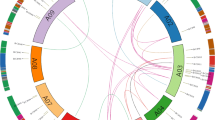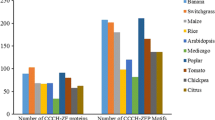Abstract
Work from animal systems indicates that C2H2 zinc finger proteins play an important role in development, and this is likely true for plant systems as well. To address this question we have used the sequence information from a previously isolated Arabidopsis thaliana C2H2 zinc finger protein gene to isolate additional cDNAs belonging to this gene family. While zinc finger genes isolated from other organisms encode multiple copies of this domain, the eight cDNAs isolated from Arabidopsis each contain only a single zinc finger. Outside of the finger region there is little sequence identity or similarity, although features characteristic of transcription factors are evident. While these genes are related, hybridization analysis indicates that each of them is a unique gene in the Arabidopsis genome. Analysis of mRNA demonstrates that the genes are expressed in different but overlapping sets of organs in the plant. These results are discussed in the light of recent analysis of zinc finger genes from other plant systems.
Similar content being viewed by others
References
Ausubel FM, Brent R, Kingston RE, Moore DD, Seidman JG, Smith JA: Current Protocols in Molecular Biology. Green Publishing Associates/Wiley Interscience, New York (1989).
Baxevanis AD, Vinson CR: Interactions of coiled coils in transcription factors: where is the specificity? Curr Opin Genet Devel 3: 278–285 (1993).
Bellefroid EJ, Marine J-C, Ried T, Lecocq PJ, Rivière M, Amenmiya C, Poncelet DA, Coulie PG, Jong PG, Szpirer C, Ward DC, Martial JA: Clustered organization of homologous KRAB zinc-finger genes with enhanced expression in human T lymphoid cells. EMBO J 12: 1363–1374 (1993).
Bellefroid EJ, Poncelet DA, Lecocq PJ, Revelant O, Martial JA: The evolutionarily conserved Krüppel-associated box domain defines a subfamily of eukaryotic multifingered proteins. Proc Natl Acad Sci USA 88: 3608–3612 (1991).
Braun T, Schofield PR, Sprengel R: Amino-terminal leucine-rich receptors determine hormone selectivity. EMBO J 10: 1885–1890 (1991).
Brendel V, Karlin S: Association of charge clusters with functional domains of cellular transcription factors. Proc Natl Acad Sci USA 86: 5698–5702 (1989).
Church GM, Gilbert W: Genomic sequencing. Proc Natl Acad Sci USA 81: 1991–1995 (1984).
Datta N, Cashmore AR: Binding of a pea nuclear protein to promoters of certain photoregulated genes is modulated by phosphorylation. Plant Cell 1: 1069–1077 (1989).
Dewdney J, Conley TR, Shih M-C, Goodman HM: Effects of blue and red light on expression of nuclear genes encoding chloroplast glyceraldehyde-3-phosphate dehydrogenase of Arabidopsis thaliana. Plant Physiol 103: 1115–1121 (1993).
Dingwall C, Laskey RA: Nuclear targeting sequences: a consensus. Trends Biochem Sci 16: 478–481 (1991).
Duboule D, Haenlin M, Galliot B, Mohier E: DNA sequences homologous to the Drosophila opa repeat are present in murine mRNAs that are differentially expressed in fetuses and adult tissues. Mol Cell Biol 7: 2003–2006 (1987).
Gerber H-P, Seipel K, Georgiev O, Höfferer M, Hug M, Rusconi S, Schaffner W: Transcriptional activation modulated by homopolymeric glutamine and proline stretches. Science 263: 808–811 (1994).
Gill G, Pascal E, Tseng ZH, Tjian R: A glutamine-rich hydrophobic patch in transcription factor Sp1 contacts the dTAFII110 component of the Drosophila TFIID complex and mediates transcriptional activation. Proc Natl Acad Sci USA 91: 192–196 (1994).
Giraudat J, Hauge BM, Valon C, Smalle J, Parcy F, Goodman HM: Isolation of the Arabidopsis ABI3 gene by positional cloning. Plant Cell 4: 1251–1261 (1992).
Grabowski DT, Carney JP, Kelley MR: A Drosophila gene containing the opa repetitive element is exclusively expressed in adult male abdomens. Nucl Acids Res 19: 1709 (1991).
Hunter T, Karin M: The regulation of transcription by phosphorylation. Cell 70: 375–387 (1992).
Jackson SP, MacDonald JJ, Lees-Miller S, Tjian R: GC box binding induces phosphorylation of Sp1 by a DNA-dependent protein kinase. Cell 63: 155–165 (1990).
Jacobs GH: Determination of the base recognition positions of zinc fingers from sequence analysis. EMBO J 11: 4507–4517 (1992).
Klimczak LJ, Schindler U, Cashmore AR: DNA binding activity of the Arabidopsis G-box binding factor GBF1 is stimulated by phosphorylation by casein kinase II from broccoli. Plant Cell 4: 87–98 (1992).
Knöchel W, Pöting A, Köster M, ElBaradi T, Nietfeld W, Bouwmeester T, Pieler T: Evolutionary conserved modules associated with zinc fingers in Xenopus laevis. Proc Natl Acad Sci USA 86: 6097–6100 (1989).
Kubasek WL, Shirley BE, McKillop A, Goodman HM, Briggs W, Ausubel F: Regulation of flavonoid biosynthetic genes in germinating Arabidopsis seedlings. Plant Cell 4: 1229–1236 (1992).
Lee I, Aukerman MJ, Gore SL, Lohman KN, Michaels SD, Weaver LM, John MC, Feldmann KA, Amasino RM: Isolation of Luminidependens: a gene involved in the control of flowering time in Arabidopsis. Plant Cell 6: 75–83 (1994).
Miller J, McLachlan AD, Klug A: Repetitive zinc-binding domains in the protein transcription factor IIIA from Xenopus oocytes. EMBO J 4: 1609–1614 (1985).
Miller M, Reddy BA, Kloc M, Li XX, Dreyer C, Etkin LD: The nuclear-cytoplasmic distribution of the Xenopus nuclear factor, xnf7, coincides with its state of phosphorylation during early development. Development 113: 569–575 (1991).
Nietfeld W, Conrad S, vanWijk I, Giltay R, Bouwmeester T, Knöchel W, Pieter T: Evidence for a clustered genomic organization of FAX-zinc finger protein encoding transcription units in Xenopus laevis. J Mol Biol 230: 400–412 (1993).
Numoto M, Niwa O, Kaplan J, Wong K-K, Merrell K, Kamiya K, Yanagihara K, Calame K: Transcriptional repressor ZF5 identifies a new conserved domain in zinc finger proteins. Nucl Acids Res 21: 3767–3775 (1993).
Papavassilou AG, Treier M, Chavrier C, Bohmann D: Targeted degradation of c-Fos, but not v-Fos by a phosphorylation-dependent signal on c-Jun. Science 258: 1941–1944 (1992).
Pavletich NP, Pabo CO: Zinc finger-DNA recognition: crystal structure of a Zif268-DNA complex at 2.1 Å. Science 252: 809–817 (1991).
Peterman TK, Goodman HM: The glutamine synthetase gene family of Arabidopsis thaliana: light-regulation and differential expression in leaves, roots and seeds. Mol Gen Genet 230: 145–154 (1991).
Picard D, Yamamoto KR: Two signals mediate hormone-dependent nuclear localization of the glucocorticoid receptor. EMBO J 6: 3333–3340 (1987).
Raikhel N: Nuclear targeting in plants. Plant Physiol 100: 1627–1632 (1992).
Sakamoto A, Minami M, Huh GH, Iwabuchi M: The putative zinc-finger protein WZF1 interacts with a cis-acting element of wheat histone genes. Eur J Biochem 217: 1049–1056 (1993).
Shieh MW, Wessler SR, Raikhel NV: Nuclear targeting of the maize R protein requires two nuclear localization sequences. Plant Physiol 101: 353–361 (1993).
Shirley BW, Hanley S, Goodman H: Effects of ionizing radiation on a plant genome: analysis of two Arabidopsis transparent testa mutations. Plant Cell 4: 333–347 (1992).
Takatsuji H, Mori M, Benfey PN, Ren L, Chua N-H: Characterization of a zinc finger DNA-binding protein expressed specifically in Petunia petals and seedling. EMBO J 11: 241–249 (1992).
Takatsuji H, Nakamura N, Katsumoto Y: A new family of zinc finger proteins in Petunia: structure, DNA sequence recognition, and floral organ-specific expression. Plant Cell 6: 947–958 (1994).
Tjaden G, Coruzzi GM: A novel AT-rich DNA binding protein that combines a HMG I-like DNA binding domain with a putative transcription domain. Plant Cell 6: 107–118 (1994).
Varagon MJ, Schmidt RJ, Raikhel NV: Nuclear localization signal(s) required for nuclear targeting of the maize regulatory protein Opaque-2. Plant Cell 4: 1213–1227 (1992).
Wharton KA, Yedvobnick B, Finnerty VG, Artavanis-Tsakonas S: opa: a novel family of transcribed repeats shared by the Notch locus and other developmentally regulated loci in D. melanogaster. Cell 40: 55–62 (1985).
Yamaguchi Y, Ruoslahti E: Expression of human proteoglycan in chinese hamster overy cells inhibits cell proteoglycan in chinese hamster overy cells inhibits cell proliferation. Nature 336: 244–246 (1998).
Zhang H, Scheirer DC, Fowle WH, Goodman HM: Expression of anitisense or sense RNA of an ankyrin repeat-containing gene blocks chloroplast differentiation in Arabidopsis. Plant Cell 4: 1575–1588 (1992).
Author information
Authors and Affiliations
Rights and permissions
About this article
Cite this article
Tague, B.W., Goodman, H.M. Characterization of a family of Arabidopsis zinc finger protein cDNAs. Plant Mol Biol 28, 267–279 (1995). https://doi.org/10.1007/BF00020246
Received:
Accepted:
Issue Date:
DOI: https://doi.org/10.1007/BF00020246




